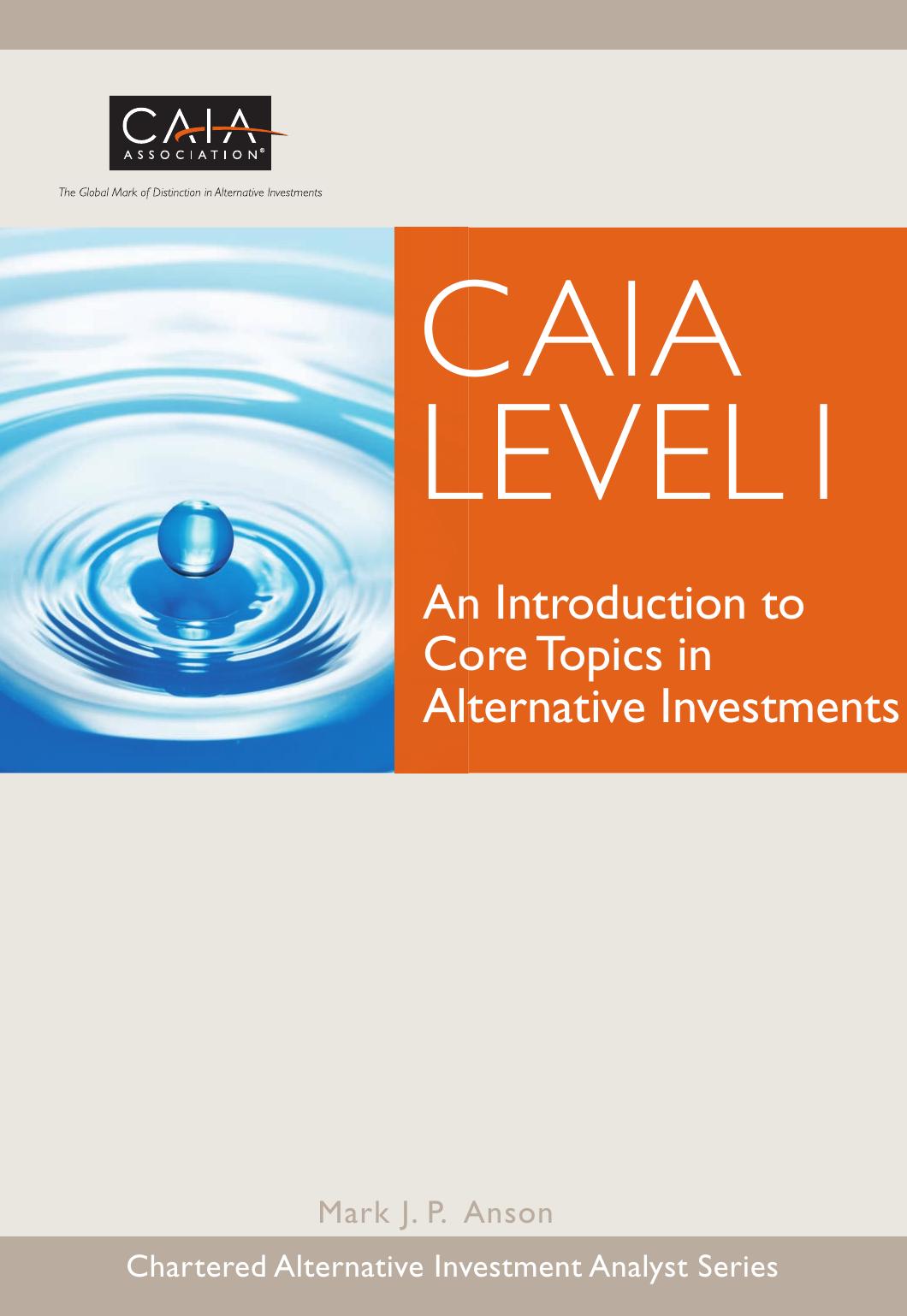CAIA Level I 1st edition by Mark Anson 9781119604150 111960415X
$70.00 Original price was: $70.00.$35.00Current price is: $35.00.
Instant download CAIA Level I An Introduction to Core Topics in Alternative Investments (Wiley) after payment
CAIA Level I 1st edition by Mark Anson – Ebook PDF Instant Download/Delivery: 9781119604150, 111960415X
Full dowload CAIA Level I 1st edition after payment

Product details:
• ISBN 10:111960415X
• ISBN 13:9781119604150
• Author: Mark Anson
Alternative Investments: CAIA Level I, 4th Edition is the curriculum book for the Chartered Alternative Investment Analyst (CAIA) Level I professional examination. Covering the fundamentals of the alternative investment space, this book helps you build a foundation in alternative investment markets. You’ll look closely at the different types of hedge fund strategies and the range of statistics used to define investment performance as you gain a deep familiarity with alternative investment terms and develop the computational ability to solve investment problems. From strategy characteristics to portfolio management strategies, this book contains the core material you will need to succeed on the CAIA Level I exam. This updated fourth edition tracks to the latest version of the exam and is accompanied by the following ancillaries: a workbook, study guide, learning objectives, and an ethics handbook.
CAIA Level I 1st Table of contents:
PART One: Introduction to Alternative Investments
CHAPTER 1: What Is an Alternative Investment?
1.1 Alternative Investments by Exclusion
1.2 Alternative Investments by Inclusion
1.3 The Blurred Lines Between Traditional and Alternative Investments
1.4 A History of Alternative Investing: The U.S. Case
1.5 Investments are Distinguished by Return Characteristics
1.6 Investments are Distinguished by Methods of Analysis
1.7 Eight Other Characteristics that Distinguish Alternative and Traditional Investments
1.8 Five Goals of Alternative Investing
1.9 Two Pillars of Alternative Investment Management
1.10 Overview of This Book
Review Questions
CHAPTER 2: The Environment of Alternative Investments
2.1 The Participants
2.2 Alternative Investment Structures
2.3 Key Features of Fund Structures
2.4 Financial Markets
2.5 Regulatory Environment
2.6 Liquid Alternative Investments
2.7 Taxation
2.8 Short Selling
Review Questions
Notes
CHAPTER 3: Quantitative Foundations
3.1 Return and Rate Mathematics
3.2 Returns Based on Notional Principal
3.3 Internal Rate of Return
3.4 Problems with Internal Rate of Return
3.5 Other Performance Measures
3.6 Illiquidity, Accounting Conservatism, IRR, and the J-Curve
3.7 Distribution of Cash Waterfall
Review Questions
Note
CHAPTER 4: Statistical Foundations
4.1 Return Distributions
4.2 Moments of the Distribution: Mean, Variance, Skewness, and Kurtosis
4.3 Covariance, Correlation, Beta, and Autocorrelation
4.4 Interpreting Standard Deviation and Variance
4.5 Testing for Normality
4.6 Time-Series Return Volatility Models
Review Questions
CHAPTER 5: Foundations of Financial Economics
5.1 Informational Market Efficiency
5.2 The Time Value of Money, Prices, and Rates
5.3 The Three Primary Theories of the Term Structure of Interest Rates
5.4 Forward Interest Rates
5.5 Arbitrage-Free Models
5.6 Binomial Tree Models
5.7 Single-Factor Default–Free Bond Models
5.8 Single-Factor Equity Pricing Models
Review Questions
Note
CHAPTER 6: Derivatives and Risk-Neutral Valuation
6.1 Foundations of Forward Contracts
6.2 Forward Contracts on Rates
6.3 Forward Contracts on Equities
6.4 Forward Contracts on Assets with Benefits and Costs of Carry
6.5 Forward Contracts Versus Futures Contracts
6.6 Managing Long-Term Futures Exposures
6.7 Option Exposures
6.8 Option Pricing Models
6.9 Option Sensitivities
Review Questions
Notes
CHAPTER 7: Measures of Risk and Performance
7.1 Measures of Risk
7.2 Estimating Value at Risk (VaR)
7.3 Benchmarking and Performance Attribution
7.4 Ratio-Based Performance Measures
7.5 Risk-Adjusted Return Measures
Review Questions
Notes
CHAPTER 8: Alpha, Beta, and Hypothesis Testing
8.1 Overview of Beta and Alpha
8.2 Ex Ante Versus Ex Post Alpha
8.3 Single-Factor Models and Regression
8.4 Inferring Ex Ante Alpha From Ex Post Alpha
8.5 Return Attribution, Alpha, and Beta
8.6 Ex Ante Alpha Estimation and Return Persistence
8.7 Return Drivers
8.8 Using Statistical Methods to Locate Alpha
8.9 Sampling and Testing Problems
8.10 Statistical Issues in Analyzing Alpha and Beta
Review Questions
Notes
PART Two: Real Assets
CHAPTER 9: Natural Resources and Land
9.1 Natural Resources Other Than Land
9.2 Land
9.3 Timber and Timberland
9.4 Farmland
9.5 Valuation and Volatility of Real Assets
9.6 Pricing and Historic Data Analysis
9.7 Contagion, Price Indices, and Biases
9.8 Key Observations Regarding Historical Returns of Timberland
9.9 Key Observations Regarding Historical Returns of Farmland
Review Questions
Notes
CHAPTER 10: Commodities
10.1 Investing in Commodities Without Futures
10.2 The Term Structure of Forward Prices on Commodities
10.3 Rolling of Forward and Futures Contracts
10.4 Normal Backwardation and Normal Contango
10.5 Commodity Exposure and Diversification
10.6 Expected Returns on Commodities
10.7 Commodity Futures Indices
10.8 Commodity Risk Attributes
10.9 Observations Based on Historical Returns
Review Questions
Notes
CHAPTER 11: Other Real Assets
11.1 Commodity Producers
11.2 Liquid Alternative Real Assets
11.3 Infrastructure
11.4 Intellectual Property Overview
11.5 Cash Flows of Intellectual Property
11.6 Visual Works of Art and Historical Performance Data
11.7 R&D and Patents as Unbundled Intellectual Property
11.8 Intellectual Property Conclusions
Review Questions
Notes
References
CHAPTER 12: Real Estate Assets and Debt
12.1 Categories of Real Estate
12.2 Advantages, Disadvantages, and Styles of Real Estate Investments
12.3 Real Estate Style Boxes
12.4 Residential Mortgages
12.5 Commercial Mortgages
12.6 Mortgage-Backed Securities Market
12.7 Liquid Alternatives: Real Estate Investment Trusts
12.8 Key Observations Regarding Historical Returns of Mortgage Reits
Review Questions
Notes
CHAPTER 13: Real Estate Equity
13.1 Real Estate Development
13.2 Commercial Real Estate Valuation
13.3 Details of the Income Approach to Real Estate Valuation
13.4 Illustration of the Income Method of Real Estate Valuation
13.5 Alternative Real Estate Investment Vehicles
13.6 Equity Reit Returns
13.7 Key Observations Regarding Historical Risks and Returns of Equity REITs
Review Questions
PART Three: Hedge Funds
CHAPTER 14: Structure of the Hedge Fund Industry
14.1 Distinguishing Hedge Funds
14.2 Hedge Fund Fees
14.3 Hedge Fund Classification
14.4 Hedge Fund Returns and Asset Allocation
14.5 Evaluating a Hedge Fund Investment Program
14.6 Three Research Studies on Whether Hedge Funds Adversely Affect the Financial Markets
14.7 Hedge Fund Indices
14.8 Conclusion
Review Questions
Notes
CHAPTER 15: Macro and Managed Futures Funds
15.1 Macro and Managed Futures Strategies
15.2 Global Macro
15.3 Managed Futures
15.4 Systematic Trading
15.5 Four Core Dimensions of Managed Futures Investment Strategies
15.6 Systematic Futures Portfolio Construction
15.7 Eight Core Benefits of Managed Futures for Investors
15.8 Evidence on Managed Futures Returns
15.9 Benefits of Managed Futures Funds
15.10 Key Observations Regarding Historical Returns of Macro and Systematic Diversified Funds
Review Questions
Notes
CHAPTER 16: Event-Driven Hedge Funds
16.1 The Sources of Most Event Strategy Returns
16.2 Activist Investing
16.3 Merger Arbitrage
16.4 Distressed Securities Funds
16.5 Event-Driven Multistrategy Funds
Review Questions
Notes
CHAPTER 17: Relative Value Hedge Funds
17.1 Overview of Relative Value Strategies
17.2 Convertible Bond Arbitrage
17.3 Volatility Arbitrage
17.4 Fixed-Income Arbitrage
17.5 Relative Value Multistrategy Funds
Review Questions
Notes
CHAPTER 18: Equity Hedge Funds
18.1 Commonalities of Equity Hedge Funds
18.2 Sources of Return
18.3 Market Anomalies
18.4 Implementing Anomaly Strategies
18.5 The Three Equity Strategies
18.6 Equity Hedge Fund Risks
Review Questions
Notes
CHAPTER 19: Funds of Hedge Funds
19.1 Overview of Funds of Hedge Funds
19.2 Investing in Multistrategy Funds
19.3 Investing in Funds of Hedge Funds
19.4 Investing in Portfolios of Single Hedge Funds
19.5 Multialternatives and Other Hedge Fund Liquid Alternatives
19.6 Key Observations Regarding Historical Returns of Funds of Funds
Review Questions
Notes
PART Four: Private Securities
CHAPTER 20: Private Equity Assets
20.1 Introduction to Private Equity Terms and Background
20.2 Overview of Three Forms of Pre-IPO Private Equity Investing
20.3 Venture Capital
20.4 Venture Capital as a Compound Option
20.5 Growth Equity
20.6 Buyouts and Leveraged Buyouts
20.7 Buyouts of Private Companies
20.8 Leveraged Buyouts (LBOs)
20.9 Merchant Banking
20.10 Dynamics of Private Equity Opportunities
Review Questions
Notes
CHAPTER 21: Private Equity Funds
21.1 Overview of Private Equity Funds
21.2 Private Equity Funds as Intermediaries
21.3 The LP and GP Relationship Life Cycle
21.4 Private Equity Fund Fees and Terms
21.5 Key Determinants of Venture Capital Fund Risks and Returns
21.6 Roles and Three Key Distinctions of Venture Capital and Buyout Managers
21.7 Leveraged Buyout Funds
21.8 Private Equity Liquid Alternatives
21.9 Private Equity Funds of Funds
21.10 Private Investments in Public Equity
21.11 Private Equity Secondary Markets and Structures
Review Questions
Notes
CHAPTER 22: Private Credit and Distressed Debt
22.1 Types of Fund Private Credit Vehicles
22.2 Fixed-Income Analysis
22.3 Credit Risk Analysis and the Bankruptcy Process
22.4 Leveraged Loans
22.5 Direct Lending
22.6 Mezzanine Debt
22.7 Distressed Debt
22.8 Private Credit Performance and Diversification
Review Questions
Note
References
PART Five: Structured Products
CHAPTER 23: Introduction to Structuring
23.1 Overview of Financial Structuring
23.2 Major Types of Structuring
23.3 The Primary Economic Role of Structuring
23.4 Collateralized Mortgage Obligations
23.5 Structural Model Approach to Credit Risk
23.6 Interest Rate Options
23.7 Introduction to Collateralized Debt Obligations
Review Questions
Note
CHAPTER 24: Credit Risk and Credit Derivatives
24.1 An Overview of Credit Risk
24.2 Reduced-Form Modeling of Credit Risk
24.3 Credit Derivatives Markets
24.4 Interest Rate Swaps
24.5 Credit Default Swaps
24.6 Other Credit Derivatives
24.7 CDS Index Products
24.8 Five Key Risks of Credit Derivatives
Review Questions
Notes
CHAPTER 25: CDO Structuring of Credit Risk
25.1 Overview of CDO Variations
25.2 Balance Sheet CDOs and Arbitrage CDOs
25.3 Mechanics of and Motivations for an Arbitrage CDO
25.4 Cash-Funded CDOs Versus Synthetic CDOs
25.5 Cash Flow CDOs Versus Market Value CDOs
25.6 Credit Enhancements
25.7 Other Types of CDOs
25.8 Risks of CDOs
Review Questions
CHAPTER 26: Equity-Linked Structured Products
26.1 Structured Products and Six Types of Wrappers
26.2 Four Potential Tax Effects of Wrappers
26.3 Structured Products with Exotic Option Features
26.4 Popular Structured Product Types
26.5 The EUSIPA Classification
26.6 Global Structured Product Cases
26.7 Structured Product Valuation
26.8 Motivations Of Structured Products
People also search for CAIA Level I 1st:
caia level i an introduction
caia level i
caia level ii curriculum
caia level 1 study guide
caia level 1 topics


